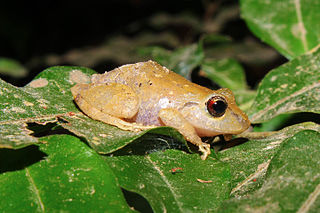
Incilius leucomyos is a species of toad in the family Bufonidae. It was described in 2000 and is endemic to the Atlantic versant of the north-central Honduras.
The bromeliad tree frog is a species of frogs in the family Hylidae.
The greater bromeliad tree frog is a species of frog in the family Hylidae endemic to the mountains of central Veracruz and northern Oaxaca, Mexico. It has been observed between 450 and 1900 meters above sea level.
The Honduran brook frog is a species of frog in the family Hylidae endemic to Honduras. Its natural habitats are subtropical or tropical moist lowland forests, subtropical or tropical moist montane forests, and rivers. Scientists have seen it between 90 and 1400 m above sea level in Honduras in rainforests.

Hyloscirtus albopunctulatus is a species of frog in the family Hylidae found in Colombia, Ecuador and Peru. Its natural habitat is subtropical or tropical moist lowland forests.
Hyloscirtus alytolylax, called the babbling stream frog, babbling torrenter, or tadapi tree frog in English, is a species of frog in the family Hylidae found in Colombia and Ecuador. Its natural habitats are subtropical or tropical moist lowland forests, subtropical or tropical moist montane forests, and rivers. It is threatened by habitat loss. Scientists have observed it in Colombia between 500 and 2159 meters above sea level and in Ecuador between 400 and 2000 meters above sea level.
The Pilalo tree frog is a species of frog in the family Hylidae endemic to Ecuador. Its natural habitats are subtropical or tropical moist montane forests and rivers. It has been observed between 2300 and 2600 meters above sea level. It is threatened by habitat loss.

Plectrohyla guatemalensis, also known as the Guatemala spikethumb frog, is a species of frog in the family Hylidae. It occurs in the highlands of the Sierra Madre from southeastern Chiapas, Mexico, and eastward through the central and southwestern highlands of Guatemala to northwestern El Salvador as well as the Sierra de Nombre de Dios in north-central Honduras. It might be a composite of more than one species.

Scinax boulengeri is a species of frog in the family Hylidae. It is found in Colombia, Costa Rica, Nicaragua, Panama, and possibly Honduras. Its natural habitats are subtropical or tropical moist lowland forests, intermittent freshwater marshes, pastureland, plantations, rural gardens, and urban areas. It has been found as high as 600 meters above sea level.

Adelophryne maranguapensis is a species of frog in the family Eleutherodactylidae. It is endemic to Serra de Maranguape, just west of Fortaleza, in Ceará state, northeastern Brazil.
Craugastor chrysozetetes is a possibly extinct species of frog in the family Craugastoridae. It is endemic to Honduras where it is only known from near its type locality on the Cerro Búfalo, Cordillera de Nombre de Dios, at the edge of the Pico Bonito National Park. Common name McCranie's robber frog has been coined for this species. However, James McCranie himself has argued that this name "should be rejected in favor of a name associated with the type locality instead of a name tied to one of the three authors who named this species".
Pristimantis ceuthospilus is a species of frog in the family Strabomantidae. It is endemic to northern Peru and occurs on the western slopes of the Cordillera de Huancabamba and the Pacific slope of the Cordillera Occidental. There are also as yet unconfirmed records from southern Ecuador. The specific name ceuthospilus, from Greek keuthos ("hidden") and spilos ("spot"), refers to the yellow spots in the groin and thighs that remain hidden when the frog is sitting. Common name Wild's robber frog has been coined for it.

Pristimantis ridens, also known as the pygmy rain frog and the Rio San Juan robber frog, is a species of frog in the family Strabomantidae. It is found in western Colombia, and then through Panama and Costa Rica to Nicaragua and eastern Honduras.
Bolitoglossa oresbia is a species of salamander in the family Plethodontidae. It is endemic to Honduras and is known from the summit of Cerro El Zarciadero and the southwestern side of the nearby Cerro Azul Meámbar National Park, in the northern Comayagua Department.
Bolitoglossa porrasorum is a species of salamander in the family Plethodontidae. It is endemic to the mountains of north-central Honduras. Common name Pijol salamander has been proposed for this species in reference to its type locality, Pico Pijol. The specific name porrasorum honors of Jorge Porras Ziuniga and Jorge Porras Orellana, father and son, who provided friendship and assistance to the describers of this species.

Raorchestes griet is a species of frog in the family Rhacophoridae. It is endemic to the Western Ghats south of the Palghat Gap in Kerala and Tamil Nadu states, India. The specific name griet honours Griet Decock, spouse of Franky Bossuyt, the scientist who described the species. Common name Griet bush frog has been coined for it.
Tepuihyla shushupe is a frog in the family Hylidae. Scientists know it exclusively from the site of collection: The headwaters of the rivers Ere and Campuya near the Colombia border within Peru. They collected the sample 145 meters above sea level.
Litoria richardsi is a species of frog in the family Hylidae, endemic to Papua New Guinea and Indonesia. Scientists have seen it about 80 m above sea level.
Zhangixalus wui, the Lichuan tree frog, is a species of frog in the family Rhacophoridae. It is endemic to China. Scientists know it exclusively from the type locality: Hanchi Village in Hubei Province. It has been observed between 1550 and 1840 meters above sea level.
Zhangixalus hongchibaensis, the Wuxi tree frog, is a frog in the family Rhacophoridae. Scientists know it from the type locality: Hongchiba in Wuxi County, Chongqing Province, China. It has been observed 1747 meters above sea level.







